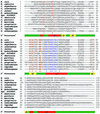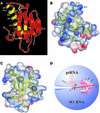Elucidation of structure-function relationships in the protein subunit of bacterial RNase P using a genetic complementation approach
- PMID: 12466529
- PMCID: PMC137979
- DOI: 10.1093/nar/gkf670
Elucidation of structure-function relationships in the protein subunit of bacterial RNase P using a genetic complementation approach
Abstract
RNase P is a ribonucleoprotein involved in tRNA biosynthesis in all living organisms. Bacterial RNase P is comprised of a catalytic RNA subunit and a lone protein cofactor which plays a supporting, albeit essential, role in the tRNA processing reaction in vivo. In this study, we have searched various databases to identify homologs of the protein subunit of RNase P from diverse bacteria and used an alignment of their primary sequences to determine the most highly conserved residues, and thereby extend earlier predictions of which residues might play an important role in RNA recognition. By employing a genetic complementation assay, we have also gained insights into structure- function relationships in the protein subunit of bacterial RNase P.
Figures





Similar articles
-
Analysis of the functional role of conserved residues in the protein subunit of ribonuclease P from Escherichia coli.J Mol Biol. 1997 Apr 11;267(4):818-29. doi: 10.1006/jmbi.1997.0906. J Mol Biol. 1997. PMID: 9135114
-
Mapping RNA-protein interactions in ribonuclease P from Escherichia coli using disulfide-linked EDTA-Fe.J Mol Biol. 2000 Feb 11;296(1):19-31. doi: 10.1006/jmbi.1999.3443. J Mol Biol. 2000. PMID: 10656815
-
Molecular modeling of the three-dimensional structure of the bacterial RNase P holoenzyme.J Mol Biol. 2003 Jan 24;325(4):661-75. doi: 10.1016/s0022-2836(02)01267-6. J Mol Biol. 2003. PMID: 12507471
-
Architecture and function of the human endonucleases RNase P and RNase MRP.IUBMB Life. 2000 Apr;49(4):265-72. doi: 10.1080/15216540050033113. IUBMB Life. 2000. PMID: 10995027 Review.
-
Structure-function analysis in nuclear RNase P RNA.Mol Biol Rep. 1995-1996;22(2-3):157-60. doi: 10.1007/BF00988722. Mol Biol Rep. 1995. PMID: 8901504 Review.
Cited by
-
The Diversity of Ribonuclease P: Protein and RNA Catalysts with Analogous Biological Functions.Biomolecules. 2016 May 13;6(2):27. doi: 10.3390/biom6020027. Biomolecules. 2016. PMID: 27187488 Free PMC article. Review.
-
Transition-state stabilization in Escherichia coli ribonuclease P RNA-mediated cleavage of model substrates.Nucleic Acids Res. 2014 Jan;42(1):631-42. doi: 10.1093/nar/gkt853. Epub 2013 Oct 3. Nucleic Acids Res. 2014. PMID: 24097434 Free PMC article.
-
M1 RNA is important for the in-cell solubility of its cognate C5 protein: Implications for RNA-mediated protein folding.RNA Biol. 2015;12(11):1198-208. doi: 10.1080/15476286.2015.1096487. Epub 2015 Oct 30. RNA Biol. 2015. PMID: 26517763 Free PMC article.
-
Studies on the mechanism of inhibition of bacterial ribonuclease P by aminoglycoside derivatives.Nucleic Acids Res. 2008 Feb;36(2):697-704. doi: 10.1093/nar/gkm1088. Epub 2007 Dec 15. Nucleic Acids Res. 2008. PMID: 18084035 Free PMC article.
-
Analysis of RNase P protein (rnpA) expression in Bacillus subtilis utilizing strains with suppressible rnpA expression.J Bacteriol. 2006 Oct;188(19):6816-23. doi: 10.1128/JB.00756-06. J Bacteriol. 2006. PMID: 16980484 Free PMC article.
References
-
- Altman S. and Kirsebom,L.A. (1999) Ribonuclease P. In Gesteland,R.F., Cech,T. and Atkins,J.F. (eds), The RNA World, 2nd Edn. Cold Spring Harbor Laboratory Press, Cold Spring Harbor, NY, pp. 351–380.
-
- Harris M.E., Frank,D. and Pace,N.R. (1998) Structure and catalytic function of the bacterial ribonuclease P ribozyme. In Simons,R.W. and Grunberg-Manago,M. (eds), RNA structure and function. Cold Spring Harbor Laboratory Press, Cold Spring Harbor, NY, pp. 309–337.
-
- Guerrier-Takada C., Gardiner,K., Marsh,T., Pace,N.R. and Altman,S. (1983) The RNA moiety of ribonuclease P is the catalytic subunit of the enzyme. Cell, 35, 849–857. - PubMed
Publication types
MeSH terms
Substances
Grants and funding
LinkOut - more resources
Full Text Sources
Molecular Biology Databases

